The demand for breakfast cereal in Japan is projected to grow from USD 2.2 billion in 2025 to USD 3.0 billion by 2035, reflecting a CAGR of 3.1%. Breakfast cereal remains a staple breakfast option in Japan, with demand driven by convenience and nutritional value. The growth is primarily fueled by an increasing interest in healthy, quick meal options, as well as growing consumer awareness about nutritional content and the availability of fortified cereals. Innovations in the cereal market, such as the introduction of gluten-free and organic varieties, have expanded the appeal of breakfast cereals among health-conscious consumers.
In addition, the growing adoption of e-commerce and online grocery shopping has made breakfast cereals more accessible to consumers, further boosting demand. The rising popularity of western-style breakfasts, alongside Japan's evolving eating habits, also contributes to the growth in breakfast cereal consumption. As consumers continue to seek convenient, balanced meals that align with their increasingly busy lifestyles, the market for breakfast cereals is set to expand. However, the growth trajectory may be tempered by competition from other breakfast alternatives such as snack bars, smoothies, and meal replacements.
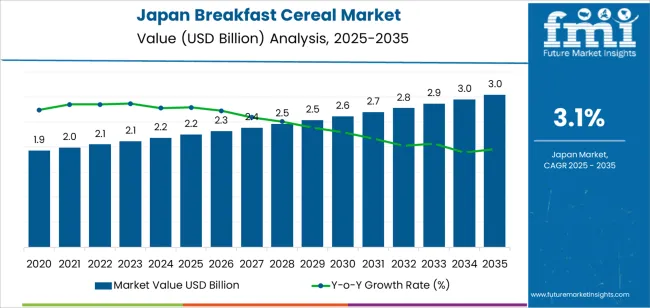
From 2025 to 2030, the demand for breakfast cereal in Japan will grow from USD 2.2 billion to USD 2.6 billion, adding USD 0.4 billion in value. During this phase, the market will experience an inflection point where growth accelerates slightly due to the expansion of health-conscious products like organic and high-protein cereals, as well as the integration of convenient packaging for on-the-go consumption. The growth momentum will be driven by consumer demand for convenience and better-for-you alternatives. As newer product lines, such as plant-based cereals and gluten-free options, gain traction, the market will see an increase in both volume and value, contributing to the early stages of the inflection point.
From 2030 to 2035, the market will grow from USD 2.6 billion to USD 3.0 billion, adding USD 0.4 billion in value. During this phase, growth will continue but at a slower rate as the market matures, marking the second part of the inflection point. Consumer preference may shift toward more diverse breakfast options, such as meal kits and snack-based alternatives, creating a competitive environment. Despite this, the demand for breakfast cereals will remain relatively stable as manufacturers innovate with premium products and new flavors to capture consumer attention. The market will likely stabilize with a steady demand, reflecting a balance between traditional cereal consumption and the rise of new meal options.
| Metric | Value |
|---|---|
| Industry Sales Value (2025) | USD 2.2 billion |
| Industry Forecast Value (2035) | USD 3 billion |
| Industry Forecast CAGR (2025 to 2035) | 3.1% |
Demand for breakfast cereal in Japan is growing as consumers seek convenient, ready-to-eat options that align with evolving lifestyles and health interests. The market is estimated at USD 2.2 billion and is expected to reach USD 3.0 billion by 2035, representing a compound annual growth rate (CAGR) of about 3.1%. Factors such as urbanisation, time constraints during morning routines, and increased consumer focus on fortified or nutrient-enhanced breakfast options drive this trend.
Product innovation and distribution channel shifts also influence demand. Manufacturers are introducing cereals with local flavour profiles, lower sugar content, and high-fibre or whole-grain formats to meet health-conscious consumer needs. Growth of online retail, convenience stores, and modern grocery formats expands access and visibility of cereal products. At the same time, constraints such as traditional breakfast habits (rice based meals), competitive snack categories, and modest domestic population growth may dampen volume acceleration. Nonetheless, given the steady shift in breakfast choice and increased product variation, the demand for breakfast cereal in Japan is positioned for moderate but sustained growth.
The demand for breakfast cereal in Japan is primarily driven by nature and product type. The leading nature is conventional, capturing 69% of the market share, while ready-to-eat cereals dominate the product type segment, accounting for 72.8% of the demand. Breakfast cereals are a convenient, quick meal choice for busy consumers, and the demand for both conventional and ready-to-eat options continues to rise, reflecting the ongoing shift towards fast and easy breakfast solutions.
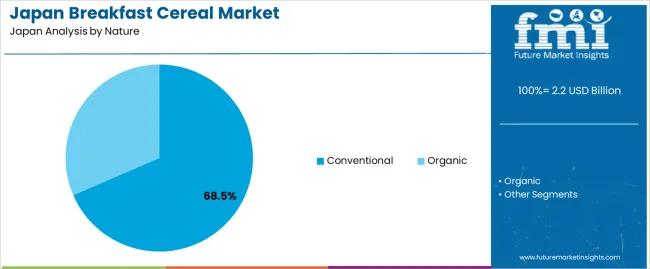
Conventional breakfast cereal leads the market in Japan, holding 69% of the demand. Conventional cereals, which are typically made from grains such as corn, wheat, or oats, are widely available and commonly consumed in Japanese households. They are preferred for their cost-effectiveness, wide range of flavors, and ease of preparation, offering a quick and convenient option for consumers, especially during busy mornings.
The demand for conventional breakfast cereals is driven by their long-standing presence in the market and their ability to cater to a wide range of tastes and preferences. Conventional cereals are often fortified with essential nutrients, making them an appealing option for consumers seeking a nutritious breakfast. Their affordability and availability in a variety of forms, such as flakes, puffs, and clusters, ensure they remain the dominant choice in the breakfast cereal market in Japan. As convenience continues to be a major factor in consumer choices, conventional cereals are expected to maintain their leadership.

Ready-to-eat cereals are the dominant product type for breakfast cereal in Japan, accounting for 72.8% of the market share. These cereals are particularly popular for their convenience, as they require no cooking and can be consumed directly from the box with minimal preparation. Ready-to-eat cereals are often marketed as a quick, nutritious option for busy individuals, making them a staple in many households.
The growing demand for ready-to-eat cereals is driven by their ability to offer a fast, easy meal without the need for cooking or special preparation. They are especially popular in urban areas, where time constraints make quick breakfast options more appealing. Furthermore, ready-to-eat cereals are often fortified with vitamins and minerals, providing consumers with a balanced breakfast. With busy lifestyles becoming more common, the demand for ready-to-eat cereals is expected to remain strong in the Japanese market.
What Are the Primary Growth Drivers for Breakfast Cereal Demand in Japan? Several factors are supporting growth. First, urbanisation and dual-income households create a need for quick, easy breakfast options, favouring ready-to-eat cereals. Second, there is a rising consumer focus on health and wellness, driving demand for cereals with added dietary benefits such as fibre and whole grains. Third, the influence of Western breakfast culture and imported brands is broadening the variety and appeal of cereals. Finally, the growth of online shopping and e-commerce platforms is making niche and premium cereal products more accessible to Japanese consumers.
What Are the Key Restraints Affecting Breakfast Cereal Demand in Japan? Despite favourable drivers, there are several constraints. Traditional Japanese breakfast habits, which favour rice, soup, and fish, limit the widespread adoption of breakfast cereals. Price sensitivity also plays a significant role, as consumers often prefer affordable options, limiting the uptake of premium or imported cereals. Additionally, many consumers prioritise natural ingredients and products with minimal additives, which places pressure on manufacturers to reformulate products, driving up costs. Finally, competition from other breakfast options like yogurt, quick breads, and snacks limits growth in the cereal category.
What Are the Key Trends Shaping Breakfast Cereal Demand in Japan? Key trends include a shift towards healthier cereals, including those with added plant-based proteins, digestive health components, and low sugar. Single-serve and smaller packaging formats are gaining popularity, particularly for on-the-go consumption by busy professionals. Premium and imported cereal varieties are becoming more popular, often incorporating local flavours like matcha or azuki bean. Additionally, the rise of e-commerce and direct-to-consumer subscription services is enabling consumers to experiment with different cereal types, increasing product variety and accessibility in Japan.
The demand for breakfast cereal in Japan shows moderate growth across different regions, with Kyushu & Okinawa leading at a CAGR of 3.8%. Kanto follows closely with a 3.5% CAGR, driven by urbanization and changing consumer preferences. The Kinki region shows a steady growth rate of 3.1%, while Chubu, Tohoku, and the Rest of Japan exhibit more modest growth, with respective CAGRs of 2.7%, 2.4%, and 2.3%. These regional variations reflect differing levels of consumer interest in breakfast cereals, urbanization, and dietary preferences, with urbanized regions showing stronger growth.

| Region | CAGR (2025-2035) |
|---|---|
| Kyushu & Okinawa | 3.8% |
| Kanto | 3.5% |
| Kinki | 3.1% |
| Chubu | 2.7% |
| Tohoku | 2.4% |
| Rest of Japan | 2.3% |
The demand for breakfast cereal in Kyushu & Okinawa is projected to grow at a CAGR of 3.8%, reflecting an increasing shift in consumer preferences towards convenience-based meals. Kyushu & Okinawa, with their dynamic consumer base and growing focus on health and wellness, are embracing breakfast cereals as an easy, nutritious option for busy mornings. The region’s younger population, combined with a growing number of health-conscious consumers, is driving this trend.
Additionally, Okinawa's increasing focus on healthy eating, influenced by its reputation for longevity and healthy lifestyles, contributes to the demand for cereals that offer balanced nutrition. As cereal manufacturers introduce healthier options, such as whole grain and fiber-rich cereals, demand is expected to continue growing. Moreover, rising awareness of Western food habits in urban areas is also playing a role in popularizing breakfast cereals.
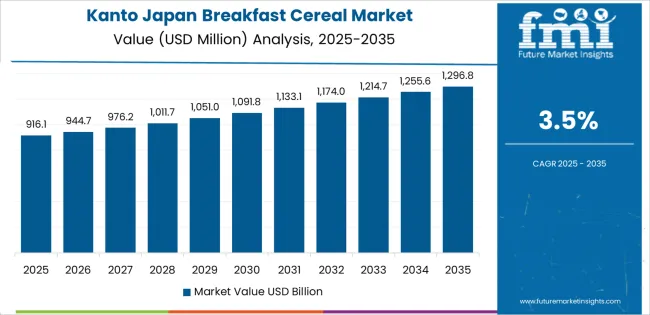
In Kanto, the demand for breakfast cereal is expected to grow at a CAGR of 3.5%, supported by the region's urbanization and fast-paced lifestyle. As the largest and most economically developed region in Japan, Kanto, particularly Tokyo, has a high population of working professionals, students, and busy families, all of whom are increasingly seeking quick, convenient breakfast options. Breakfast cereal, known for its ease of preparation and health benefits, is gaining popularity as a quick meal that fits well into modern, on-the-go lifestyles.
Furthermore, as consumer awareness of health and nutrition increases, many are opting for cereals that provide fiber, vitamins, and minerals. The demand for cereal is also influenced by growing exposure to Western diets, particularly in urban centers where international food trends have a stronger presence. The availability of various product types, from traditional to gluten-free and organic cereals, continues to support market growth in Kanto.
The demand for breakfast cereal in the Kinki region is projected to grow at a CAGR of 3.1%, reflecting steady, moderate growth. Kinki, home to cities such as Osaka and Kyoto, has a long history of traditional food consumption, but urbanization and modernization are gradually shifting consumer preferences. As younger generations in Kinki adopt more Westernized eating habits, there is a growing interest in convenience foods like breakfast cereals.
However, the region still retains a strong cultural preference for traditional Japanese breakfast items, such as rice and miso soup, which may moderate the adoption of cereals. Despite this, the increasing availability of healthier cereal options and the influence of busy work schedules are contributing to the growth of the market. The region’s mix of traditional and modern food preferences ensures steady demand for breakfast cereal, though the growth rate remains moderate compared to other urbanized regions.
How is the demand for breakfast cereal growing in Chubu?
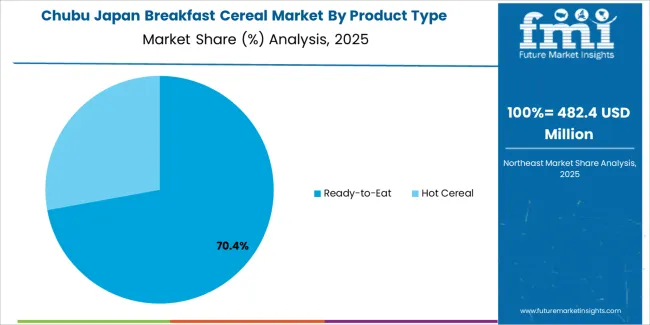
The demand for breakfast cereal in Chubu is expected to grow at a CAGR of 2.7%, reflecting slower adoption in comparison to more urbanized regions like Kanto and Kyushu & Okinawa. Chubu, which includes cities like Nagoya, has a strong food culture centered on rice and traditional Japanese breakfasts. While breakfast cereals are available, the region still exhibits a preference for conventional breakfast foods. However, as lifestyle changes, particularly in larger cities, lead to busier mornings, the demand for quicker, more convenient meals, such as breakfast cereal, is gradually rising. The growth rate remains relatively slow as traditional breakfast habits persist, but the increasing availability of breakfast cereals in supermarkets and the growing interest in healthier, easy-to-prepare options may help sustain moderate demand for cereal products in the region.
In Tohoku, the demand for breakfast cereal is projected to grow at a CAGR of 2.4%, indicating a slow but steady increase. Tohoku, which is more rural and less urbanized compared to other regions, maintains a strong preference for traditional Japanese breakfasts. However, there is a growing awareness of the convenience and health benefits of breakfast cereals, particularly among younger consumers and those living in urban centers like Sendai.
The slower growth in this region can be attributed to a more conservative approach to changing dietary habits and a stronger cultural attachment to rice-based breakfasts. Despite this, the increasing exposure to Western foods and growing health-consciousness are gradually driving adoption. As supermarket chains expand their product offerings and the convenience of breakfast cereal continues to appeal to time-strapped individuals, the demand for breakfast cereals in Tohoku is expected to grow, albeit at a slower pace.
In the Rest of Japan, the demand for breakfast cereal is expected to grow at a CAGR of 2.3%, reflecting a slower, more gradual increase in adoption. This region, which encompasses rural and less densely populated areas, has a stronger reliance on traditional Japanese breakfasts, and the consumption of cereal has historically been lower. However, as convenience-driven eating habits begin to spread and younger generations embrace Western dietary influences, breakfast cereals are slowly gaining popularity.
The growth is tempered by the continued dominance of rice-based breakfasts, but as more health-conscious products enter the market and as convenience becomes a larger factor in food choices, the demand for breakfast cereal in these areas is expected to increase incrementally. The overall growth rate remains slower than in more urbanized areas due to the region's attachment to traditional food practices.
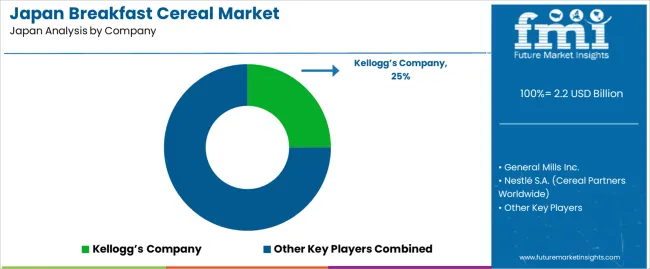
Demand for breakfast cereals in Japan is growing, driven by busy lifestyles and an increasing focus on health. Major companies in this segment include Kellogg’s Company (holding approximately 25% market share), General Mills Inc., Nestlé S.A. (through Cereal Partners Worldwide), Post Holdings, Inc., and PepsiCo (via Quaker Oats). As Japanese consumers seek convenient breakfast options, ready to eat cereals are becoming more popular, though traditional breakfasts remain common.
Competition in the breakfast cereal industry in Japan revolves around product innovation, local flavor preferences, and health-conscious offerings. Companies are introducing cereals with flavors that cater to Japanese tastes, such as matcha, black sesame, and other unique blends. There is also a focus on the nutritional aspects of the products, with manufacturers offering cereals that include whole grains, added fiber, and reduced sugar to appeal to the growing interest in wellness. Distribution is key, with products available through convenience stores, online retail, and supermarkets. Companies are leveraging these strategies to adapt to consumer preferences and solidify their position in Japan’s breakfast cereal market.
| Items | Details |
|---|---|
| Quantitative Units | USD Billion |
| Regions Covered | Japan |
| Nature | Conventional, Organic |
| Product Type | Ready-to-Eat, Hot Cereal |
| Sales Channel | Modern Trade, Online Retail Stores, Traditional Grocery Stores, Convenience Stores, Specialty Stores |
| Key Companies Profiled | Kellogg’s Company, General Mills Inc., Nestlé S.A. (Cereal Partners Worldwide), Post Holdings, Inc., PepsiCo (Quaker Oats) |
| Additional Attributes | The market analysis includes dollar sales by nature, product type, sales channel, and company categories. It also covers regional demand trends in Japan, particularly driven by the growing adoption of both ready-to-eat and hot cereals in modern retail and convenience stores. The competitive landscape highlights key manufacturers focusing on innovations in cereal formulations, packaging, and health-conscious options. Trends in the increasing demand for organic and nutritious breakfast options, particularly in online and traditional grocery retail, are explored, along with advancements in product varieties and consumer preferences. |
The demand for breakfast cereal in japan is estimated to be valued at USD 2.2 billion in 2025.
The market size for the breakfast cereal in japan is projected to reach USD 3.0 billion by 2035.
The demand for breakfast cereal in japan is expected to grow at a 3.1% CAGR between 2025 and 2035.
The key product types in breakfast cereal in japan are conventional and organic.
In terms of product type, ready-to-eat segment is expected to command 72.8% share in the breakfast cereal in japan in 2025.






Our Research Products

The "Full Research Suite" delivers actionable market intel, deep dives on markets or technologies, so clients act faster, cut risk, and unlock growth.

The Leaderboard benchmarks and ranks top vendors, classifying them as Established Leaders, Leading Challengers, or Disruptors & Challengers.

Locates where complements amplify value and substitutes erode it, forecasting net impact by horizon

We deliver granular, decision-grade intel: market sizing, 5-year forecasts, pricing, adoption, usage, revenue, and operational KPIs—plus competitor tracking, regulation, and value chains—across 60 countries broadly.

Spot the shifts before they hit your P&L. We track inflection points, adoption curves, pricing moves, and ecosystem plays to show where demand is heading, why it is changing, and what to do next across high-growth markets and disruptive tech

Real-time reads of user behavior. We track shifting priorities, perceptions of today’s and next-gen services, and provider experience, then pace how fast tech moves from trial to adoption, blending buyer, consumer, and channel inputs with social signals (#WhySwitch, #UX).

Partner with our analyst team to build a custom report designed around your business priorities. From analysing market trends to assessing competitors or crafting bespoke datasets, we tailor insights to your needs.
Supplier Intelligence
Discovery & Profiling
Capacity & Footprint
Performance & Risk
Compliance & Governance
Commercial Readiness
Who Supplies Whom
Scorecards & Shortlists
Playbooks & Docs
Category Intelligence
Definition & Scope
Demand & Use Cases
Cost Drivers
Market Structure
Supply Chain Map
Trade & Policy
Operating Norms
Deliverables
Buyer Intelligence
Account Basics
Spend & Scope
Procurement Model
Vendor Requirements
Terms & Policies
Entry Strategy
Pain Points & Triggers
Outputs
Pricing Analysis
Benchmarks
Trends
Should-Cost
Indexation
Landed Cost
Commercial Terms
Deliverables
Brand Analysis
Positioning & Value Prop
Share & Presence
Customer Evidence
Go-to-Market
Digital & Reputation
Compliance & Trust
KPIs & Gaps
Outputs
Full Research Suite comprises of:
Market outlook & trends analysis
Interviews & case studies
Strategic recommendations
Vendor profiles & capabilities analysis
5-year forecasts
8 regions and 60+ country-level data splits
Market segment data splits
12 months of continuous data updates
DELIVERED AS:
PDF EXCEL ONLINE
Breakfast Cereal Market Trends – Healthy & Indulgent Options Driving Growth 2025 to 2035
Demand for Breakfast Takeout in Japan Size and Share Forecast Outlook 2025 to 2035
Japan Faith-based Tourism Market Size and Share Forecast Outlook 2025 to 2035
Japan Sports Tourism Market Size and Share Forecast Outlook 2025 to 2035
Japan Respiratory Inhaler Devices Market Size and Share Forecast Outlook 2025 to 2035
Japan Halal Tourism Market Size and Share Forecast Outlook 2025 to 2035
Breakfast Drinks Market Size and Share Forecast Outlook 2025 to 2035
Japan Automated People Mover Industry Size and Share Forecast Outlook 2025 to 2035
Japan Automotive Load Floor Industry Analysis Size and Share Forecast Outlook 2025 to 2035
Japan Food Cling Film Market Size and Share Forecast Outlook 2025 to 2035
Japan Polypropylene Packaging Films Market Size and Share Forecast Outlook 2025 to 2035
Cereal Flour Market Size and Share Forecast Outlook 2025 to 2035
Japan Probiotic Yogurt Market is segmented by product type, source type, nature type, flavor type, fat content, sales channel and key city/province through 2025 to 2035.
japan Tortilla Market - Growth, Trends and Forecast from 2025 to 2035
Japan Cosmetics ODM Market Analysis - Size, Share & Trends 2025 to 2035
Japan Automotive Turbocharger Market Insights – Demand, Size & Industry Trends 2025–2035
Japan Yeast Market Insights – Demand, Size & Industry Trends 2025–2035
Japan Green and Bio-based Polyol Market Insights – Demand, Size & Industry Trends 2025–2035
Japan Natural Food Color Market Trends – Growth, Demand & Forecast 2025–2035
Japan Coated Fabrics Market Growth – Trends, Demand & Innovations 2025–2035

Thank you!
You will receive an email from our Business Development Manager. Please be sure to check your SPAM/JUNK folder too.
Chat With
MaRIA